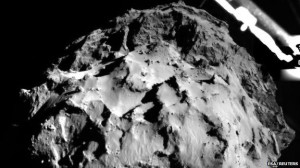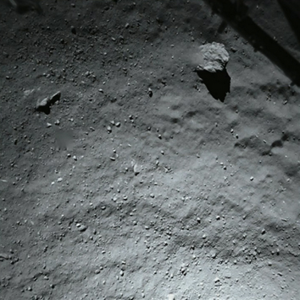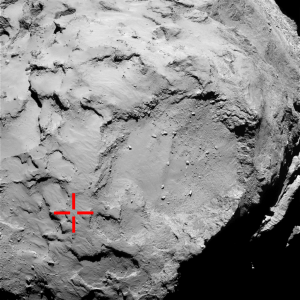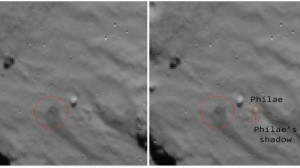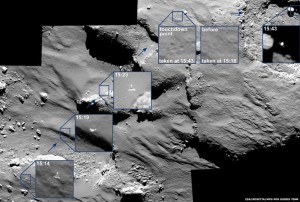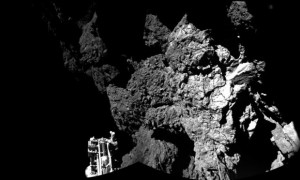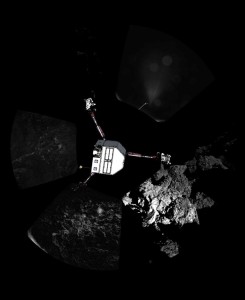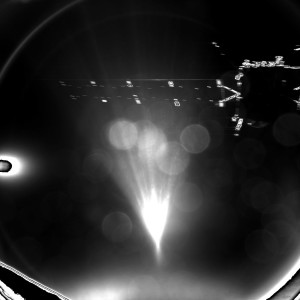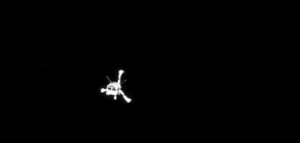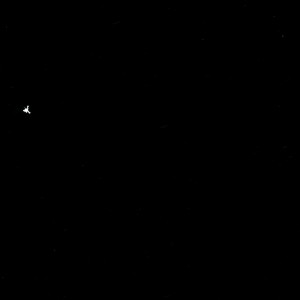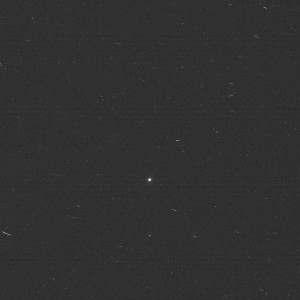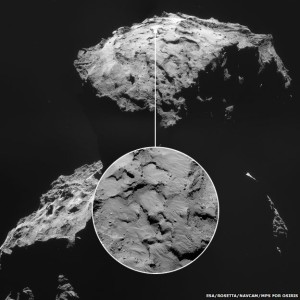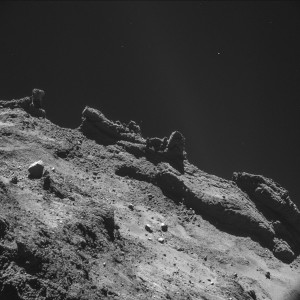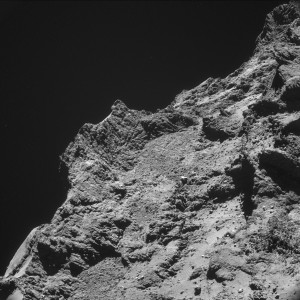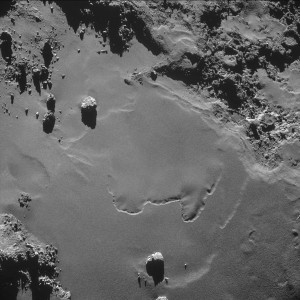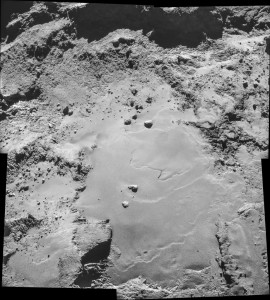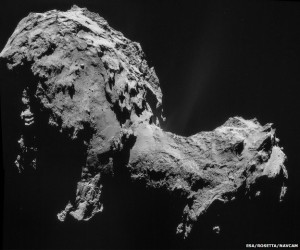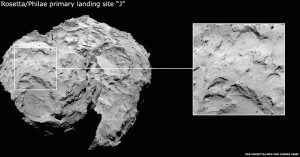So, the long journey is over. The Europeans Space Agency’s probe Rosetta was purposely crashed into the surface of (deep breath) Comet 67P/Churyumov-Gerasimenko just a few minutes ago, landing just 40 m away from its intended target. It now joins the doughty, though ill-fated lander module Philae on the surface of the comet.
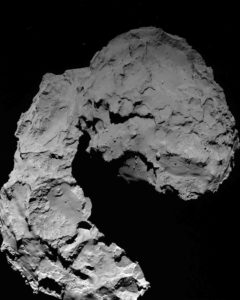
Rosetta’s OSIRIS wide-angle camera captured this image on 29 September 2016 at 11:49 GMT yesterday when Rosetta was 22.9 km from Comet 67P/Churyumov-Gerasimenko. Photograph: Credits: ESA/Rosetta/MPS for OSIRIS Team MPS/UPD/LAM/IAA/SSO/INTA/UPM/DASP/IDA
Rosetta sent many fantastic images back to us here on earth, and the close-up details of the comet’s surface on her descent are amazing.
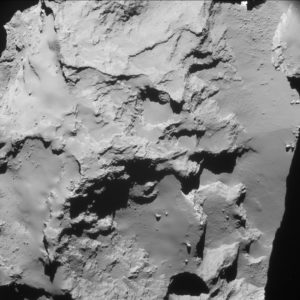
Single frame enhanced NavCam image taken on 29 September 2016 at 22:53 GMT, when Rosetta was 20 km from the centre of the nucleus of Comet 67P/Churyumov-Gerasimenko. The scale at the surface is about 1.7 m/pixel and the image measures about 1.7 km across. ESA/Rosetta/NAVCAM – CC BY-SA IGO 3.0
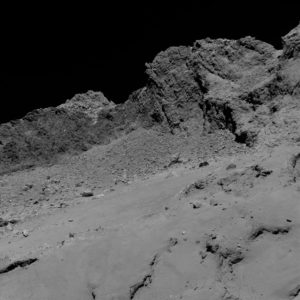
Rosetta’s OSIRIS narrow-angle camera captured this image of Comet 67P/Churyumov-Gerasimenko on 30 September at 01:20 GMT from an altitude of about 16 km above the surface during the spacecraft’s final descent . The image scale is about 30 cm/pixel and the image measures about 614 m across. Credit: ESA/Rosetta/MPS for OSIRIS Team MPS/UPD/LAM/IAA/SSO/INTA/UPM/DASP/IDA
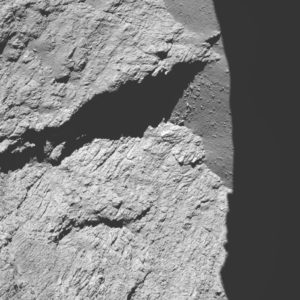
Comet 67P/C-G viewed with Rosetta’s OSIRIS NAC on 30 September 2016 at 05:25 GMT, 11.7 km from the surface. The image scale is about 22 cm/pixel and the image measures about 450 m across. Credit: ESA/Rosetta/MPS for OSIRIS Team MPS/UPD/LAM/IAA/SSO/INTA/UPM/DASP/IDA
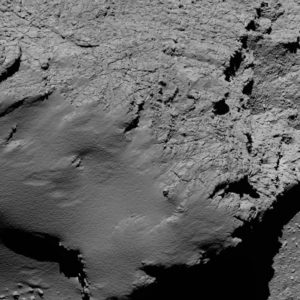
Comet 67P/C-G viewed with Rosetta’s OSIRIS NAC on 30 September 2016 at 06:53 GMT, 8.9 km from the surface. The image scale is about 17 cm/pixel and the image measures about 350 m across. Credit: ESA/Rosetta/MPS for OSIRIS Team MPS/UPD/LAM/IAA/SSO/INTA/UPM/DASP/IDA
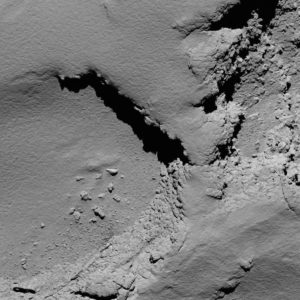
Comet 67P/C-G viewed with Rosetta’s OSIRIS NAC on 30 September 2016 at 08:18 GMT, 5.8 km from the surface. The image scale is about 11 cm/pixel and the image measures about 225 m across. Credit: ESA/Rosetta/MPS for OSIRIS Team MPS/UPD/LAM/IAA/SSO/INTA/UPM/DASP/IDA
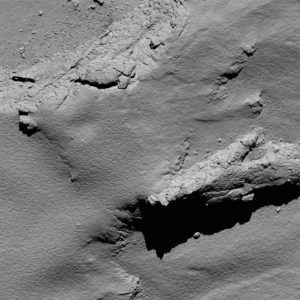
Comet 67P/C-G viewed with Rosetta’s OSIRIS NAC on 30 September 2016 at 8.21 GMT, 5.7 km from the surface. The image scale is about 11 cm/pixel and the image measures about 225 m across. Credit: ESA/Rosetta/MPS for OSIRIS Team MPS/UPD/LAM/IAA/SSO/INTA/UPM/DASP/IDA
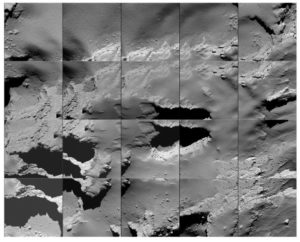
Modern art, or Rosetta scans of its landing site? Credit: ESA/Rosetta/MPS for OSIRIS Team MPS/UPD/LAM/IAA/SSO/INTA/UPM/DASP/IDA
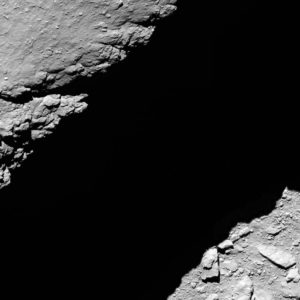
OSIRIS narrow-angle camera shot of Comet 67P/Churyumov-Gerasimenko captured from an altitude of about 1.2 km on 30 September at 10:14 GMT. The image scale is about 2.3 cm/pixel and the image measures about 33 m across.
The crash will have damaged mechanisms on Rosetta and as sunlight will be fading as the comet moves away from the sun, even if the solar panels and other equipment had survived the crash, the panels would not have been able to generate enough power to send any more data back. The scientists took readings all the way down on the descent, and decided not to fire thrusters to slow the descent for fear of the exhaust gases contaminating the readings taken on the way down.
Rosetta was due to touch down / crash at 11.38 BST (GMT +1), but because of the distance of the comet from the earth, confirmation took just over 40 minutes to get here, reaching us at 12.19 BST.
A fabulous end to an amazing mission. Space science at its best, indeed.
